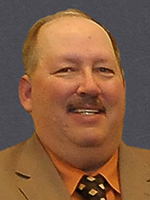
Reflections on the 2020 U.S. custom harvesting season
The 2020 harvest season was a year unlike any other, but many U.S. custom harvesters adapted and chopped quality forages for their customers. We caught up with three U.S. Custom Harvesters, Inc. (USCHI) board members to get their reflections on this year’s harvest.
 Glen Jantzen, owner of Jantzen Harvesting LLC and president of USCHI (Plymouth, Nebraska)
Glen Jantzen, owner of Jantzen Harvesting LLC and president of USCHI (Plymouth, Nebraska)
About an hour southwest of Lincoln, Nebraska, is the headquarters for Jantzen Harvesting LLC, a family business owned by Glen Jantzen and his wife, Linda. They operate three Claas choppers with four full-time employees and four to six seasonal employees. Their harvest season starts in April with winter cereal and alfalfa harvests in Kansas, Oklahoma, and Arkansas. By May, they move into Nebraska and then into the Dakotas, Wyoming, and Montana in June. Then they turn around and start chopping corn silage.
While spring harvest went well, Jantzen said this year “was, has been and is a different year” from any he has ever experienced in his 29 years of harvesting. He explained that many operations had issues with labor and travel because of the pandemic. However, since some operations couldn’t run at full capacity, Jantzen and his crew were able to help out and pick up more work, making it a win-win for everyone.
As for corn silage harvest, Jantzen said the biggest challenge for his team was weather. He explained how many of his customers experienced ample amounts of rain through late July and everything was growing well, then the rain stopped and temperatures increased. Within a week, Jantzen said everything went from too wet to too dry. Then, while they were still harvesting corn silage in the south, an early September frost in the northern states moved harvest dates up. Additionally, although they didn’t have many rain delays throughout the year, they did have one week of rain in September that shut down everything for 10 days, which set them back a little bit.
Jantzen and his team wrapped up their harvest season on November 7. While this year’s harvest may not have been above average, he estimated that yields and quality weren’t too far off from a typical year, even in the drier areas. Jantzen also expressed he was grateful everyone stayed healthy, they didn’t have many equipment issues, and they had zero accidents or injuries.
“We had a good enough year that we get to do it again next year,” he said.
 Raph Jolliffe, owner of Outlaw Ag LLC and vice president of USCHI (Stratton, Colorado)
Raph Jolliffe, owner of Outlaw Ag LLC and vice president of USCHI (Stratton, Colorado)
In eastern Colorado, Raph Jolliffe said the 2020 chopping season started out fast and ended early. His family-owned, one-chopper operation, Outlaw Ag LLC, typically works within a 100-mile radius of Stratton, Colorado. This spring, they got out to a good start chopping alfalfa and barley for their customers and had good-quality and average yields coming out of the fields.
However, as things started rolling in the spring, the COVID-19 pandemic hit, which he said put a strain on many operations in terms of labor and feeding their teams. Jolliffe explained that many would-be employees chose not to join harvest operations this year because of the pandemic, leaving many teams short-handed. On the other hand, he said the crews that could field a full team of 10- to 30-plus employees encountered challenges related to feeding everyone because of limitations placed on specific grocery items.
As the spring rolled into the summer, Jolliffe said widespread drought became an issue that would cause most crops to be harvested early and at lower yields. He said they chopped a lot of corn for silage that was meant to be picked for grain, and a lot of producers are now trying to buy hay and other forages to supplement their inventories.
Jolliffe and his team finished chopping about a month ago, but he said some operations in other areas are still finishing up. While their season was cut short due to a lack of crops to chop, Jolliffe said the silver lining was they didn’t have to fight much mud, which always makes for fewer headaches.
Overall, Jolliffe is content with the work he and his team completed for their customers.
“It wasn’t a stellar season, but we fought through it,” he said.
 Jon Orr, majority owner of Orrson Custom Farming LTD. and a director of USCHI (Apple Creek, Ohio)
Jon Orr, majority owner of Orrson Custom Farming LTD. and a director of USCHI (Apple Creek, Ohio)
Jon Orr is the majority owner of Orrson Custom Farming LTD., headquartered in Apple Creek, Ohio. They employ 14 to 16 people during the season to run two choppers, eight to 10 trucks, and four packing tractors. In spring 2020, they started chopping rye grass and oats for silage in Georgia, then they switched over to corn silage in July and worked their way up through western Ohio and into Michigan.
As in other areas of the U.S., Orr said weather was a lot more friendly to them this year, which helped them avoid major setbacks. In addition, he said the machinery and processors held up well throughout the season. All of these variables allowed Orr and his team to “chop a lot of good feed, and customers should have a lot of happy cows.”
Orr said he was very proud of the work his team did this year. He said many dairy producers were pleased with the length of cut and processing of the crops. On one dairy in Michigan, where Orr was helping a fellow harvester, the producer was surprised how reliable their eight-year-old chopper was compared to the newer ones on the other crew. Another particular point of pride for Orr was when his team put up more than 6,000 tons of corn silage in a day.
Their biggest challenges this year were related to feeding the team during the pandemic. Orr said, after ordering take-out and fast food for several weeks, they purchased a grill, allowing them to break up the monotony of the work and have some important time together as a team.
When everything was said and done, Orr and his team wrapped up harvest on October 7. He said it was a good year because they achieved the three goals they wanted to achieve this year:
- They had no injuries or accidents, and everybody went home happy and healthy.
- They made some good memories together.
- They put up quality feed and made a profit.
“If you can achieve your first three goals, it will be a good year,” Orr said.
| Category: |
Forage Foundations Forage harvesting |

